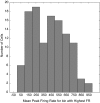Activity of long-lead burst neurons in pontine reticular formation during head-unrestrained gaze shifts
- PMID: 24174648
- PMCID: PMC3921377
- DOI: 10.1152/jn.00841.2012
Activity of long-lead burst neurons in pontine reticular formation during head-unrestrained gaze shifts
Abstract
Primates explore a visual scene through a succession of saccades. Much of what is known about the neural circuitry that generates these movements has come from neurophysiological studies using subjects with their heads restrained. Horizontal saccades and the horizontal components of oblique saccades are associated with high-frequency bursts of spikes in medium-lead burst neurons (MLBs) and long-lead burst neurons (LLBNs) in the paramedian pontine reticular formation. For LLBNs, the high-frequency burst is preceded by a low-frequency prelude that begins 12-150 ms before saccade onset. In terms of the lead time between the onset of prelude activity and saccade onset, the anatomical projections, and the movement field characteristics, LLBNs are a heterogeneous group of neurons. Whether this heterogeneity is endemic of multiple functional subclasses is an open question. One possibility is that some may carry signals related to head movement. We recorded from LLBNs while monkeys performed head-unrestrained gaze shifts, during which the kinematics of the eye and head components were dissociable. Many cells had peak firing rates that never exceeded 200 spikes/s for gaze shifts of any vector. The activity of these low-frequency cells often persisted beyond the end of the gaze shift and was usually related to head-movement kinematics. A subset was tested during head-unrestrained pursuit and showed clear modulation in the absence of saccades. These "low-frequency" cells were intermingled with MLBs and traditional LLBNs and may represent a separate functional class carrying signals related to head movement.
Keywords: PPRF; gaze; head movement; primate; saccade.
Figures











Similar articles
-
Gaze shift duration, independent of amplitude, influences the number of spikes in the burst for medium-lead burst neurons in pontine reticular formation.Exp Brain Res. 2011 Oct;214(2):225-39. doi: 10.1007/s00221-011-2823-8. Epub 2011 Aug 14. Exp Brain Res. 2011. PMID: 21842410 Free PMC article.
-
Comparing extraocular motoneuron discharges during head-restrained saccades and head-unrestrained gaze shifts.J Neurophysiol. 2000 Jan;83(1):630-7. doi: 10.1152/jn.2000.83.1.630. J Neurophysiol. 2000. PMID: 10634902
-
Spatial characteristics of neurons in the central mesencephalic reticular formation (cMRF) of head-unrestrained monkeys.Exp Brain Res. 2006 Jan;168(4):455-70. doi: 10.1007/s00221-005-0104-0. Epub 2005 Nov 15. Exp Brain Res. 2006. PMID: 16292575
-
Spatio-temporal recoding of rapid eye movement signals in the monkey paramedian pontine reticular formation (PPRF).Exp Brain Res. 1983;52(1):105-20. doi: 10.1007/BF00237155. Exp Brain Res. 1983. PMID: 6628590
-
Studies of the role of the paramedian pontine reticular formation in the control of head-restrained and head-unrestrained gaze shifts.Ann N Y Acad Sci. 2002 Apr;956:85-98. doi: 10.1111/j.1749-6632.2002.tb02811.x. Ann N Y Acad Sci. 2002. PMID: 11960796 Review.
Cited by
-
Eye movement abnormalities in movement disorders.Clin Park Relat Disord. 2019 Aug 30;1:54-63. doi: 10.1016/j.prdoa.2019.08.004. eCollection 2019. Clin Park Relat Disord. 2019. PMID: 34316601 Free PMC article. Review.
References
-
- Bahill AT, Clark MR, Stark L. The main sequence, a tool for studying human eye movements. Math Biosci 24: 191–204, 1975
-
- Bahill AT, Stark L. Oblique saccadic eye movements. Independence of horizontal and vertical channels. Arch Ophthalmol 95: 1258–1261, 1977 - PubMed
-
- Baloh RW, Konrad HR, Sills AW, Honrubia V. The saccade velocity test. Neurology 25: 1071–1076, 1975a - PubMed
-
- Baloh RW, Sills AW, Kumley WE, Honrubia V. Quantitative measurement of saccade amplitude, duration, and velocity. Neurology 25: 1065–1070, 1975b - PubMed
-
- Becker W. The neurobiology of saccadic eye movements. Metrics Rev Oculomot Res 3: 13–67, 1989 - PubMed
Publication types
MeSH terms
Grants and funding
LinkOut - more resources
Full Text Sources
Other Literature Sources

